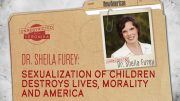
In June, the Obama administration began reviving efforts to have the United States sign onto a global children’s rights treaty “ratified by every U.N. member except the U.S. and Somalia,” according to the U.S. ambassador to the United Nations, Susan Rice. The Huffington Post’s account implies, in that single quote, a moral equivalency between the United States and a Third World nation utterly hostile to the plight of human populations.
At this writing, administration officials are concocting a strategy to goad reticent legislators into jumping on the bandwagon. Rice’s discreet language, of course, was soothing to the untutored ear, and the choice of podium for her boss’s rallying call befitted a children’s rights platform — a school in Harlem, where she fielded a student’s no doubt carefully scripted question concerning the UN’s Convention on the Rights of the Child (CRC), making the idea saleable to the public.
The Harlem Children’s Zone, with its mostly minority junior high students, was the perfect backdrop for an announcement hailing the CRC’s ratification as “long overdue.” Who in America, after all, could be opposed to rights for children? Most truly believe treaties like the CRC help “make the world safe for democracy” by nurturing and furthering American values.
The treaty states that children have a right to education, healthcare, and protection from abuse. Supporters claim it has improved children’s lives in places like Lebanon, South Korea, South Africa and Sri Lanka, although the victims of child brothels and illegal sex trafficking might beg to differ.
Opponents in the United States have argued that UN decrees and treaties invite foreign interference in U.S. governance. They say the CRC could undermine parents’ rights to raise children in a manner consistent with their own values.
But parents’ rights in the United States have been under attack for a long time, especially at the federal level, from which megabucks trickle down to state and local agencies, as in education. Beginning with the tome Toward World Understanding, by the National Education Association, which co-founded United Nations Educational, Scientific and Cultural Organization (UNESCO) in the 1940s, parental prerogatives have been challenged. By the late 1970s, the push to weaken parental authority in favor of the State was in full force. Ubiquitous curriculums like the “Model UN” helped lend authenticity to this view.
Today, after some 40 years of UNESCO-inspired schooling and leftist control of most media outlets, even educated, well-meaning folks say they do not understand how UN treaties, declarations, and proclamations conflict with U.S. laws, the Constitution, or even the ideals set forth by the Founding Fathers.
The UN’s cause célèbre is advancing “human rights,” but its declarations and proclamations, including the CRC, do not mean personal rights or self-determination as our forebears knew them. The UN version has everything to do with advancing group consensus, transfers of wealth and relegating the family to “breeders and feeders.” However, one has to study UN statements closely — very closely — to get the message. Just enough words are plagiarized from our founding documents to make UN pronouncements sound credible, and just enough words are surreptitiously inserted to fool the inattentive. Today’s mainstream media, with two-minute segments passed off as in-depth reporting, and quickie print mediums like USA Today, that supposedly tell you everything you need to know in one sentence or a headline, have conditioned us to scan, not actually read. The Human Rights Council, for example, is ludicrously headed by “member states” hostile to human rights (e.g., Libya). Some free-worlders grimace, hoping that some decency or other will inadvertently “rub off” on delinquent nations.
With this in mind, let us examine this UN construct, the Rights of the Child.
Article 14, for example, tells parents to “respect the right of the child to freedom of thought, conscience and religion.”
This might pass if parents were encouraged to transmit traditional moral and spiritual boundaries. But in a value-neutral culture where children are assaulted with every sort of perversion, from innuendoes to images, it is a recipe for disaster. Given that fact, it’s easy to lump countries like Somalia with the United States. Leaders who wink at selling children, genital mutilation, and infanticide begin to bear a passing resemblance to New Age, free-world ideologies like euthanasia, abortion, and rationed healthcare.
Article 14 also includes the “freedom to manifest one’s religion or beliefs … subject only to such limitations as are prescribed by law and are necessary to protect public safety, order, health or morals, or the fundamental rights and freedoms of others.”
But who are the “others” in need of protection? As Berit Kjos, points out, in The UN Seizure of Parental Rights, those “others” are mostly people who look askance at the Christian Bible and who are offended by its moral standards. This would include most American schools, government agencies and, increasingly, civil law. As this article is written, a Florida school principal and athletic director face jail time for offering grace at mealtime, thanks to the American Civil Liberties Union.
So, the “others” being protected here are the ACLU, which originated as a Communist front organization passing itself off as a guardian of civil rights, while local students, teachers and parents get the shaft.
Article 15’s “freedom of association” is misleading, along with Article 16, which forbids “interference with [a child’s] privacy…or correspondence.” Here we touch heavily on the parental authority. Suppose a child is consorting with a drug dealer, or meets a pervert online who initiates a relationship? Too bad, according the UN’s CRC, interference means parents, too.
In effect, the UN is “freeing” the child to seek the approval of the peer group, not conform to parental demands. This falls right in line with a relatively new concept called “social justice,” as opposed to justice under the U.S. Constitution — something Americans have unwittingly signed onto without a clue as to what it means or how it flies in the face of the Founders’ version of “justice.”
“Justice” in the Founder’s view was grounded in “action.” Acts — what you do to me and what I do to you — perpetrated by either individuals or groups, and deemed legal or illegal according to specified laws. In the 1960’s, “justice” in America started being nudged away from this definition, again by the UN, and toward a nebulous concept of “fairness” — something built into United Nations ideology from its founding. From that small beginning, the World Federation for Mental Health emerged, reversing the American Founders’ vision about the relationship of government to the governed and correlating notions about freedom of the individual. In fact, the Federation’s founding document was entitled “Mental Health and World Citizenship,” and its gurus were avid, proselytizers of atheism and socialism, such as Drs. Brock Chisholm, Ewen Cameron, and John Rawlings Rees. The latter went so far as to tell colleagues in a 1940 speech that the mental health movement should take a page out of the totalitarian handbook and become “a fifth column” in order to gain legitimacy in every field, from education to medicine.
So it is no surprise that the UN’s Universal Declaration of Human Rights, for example, changes Thomas Jefferson’s line about pursuit of happiness to affirm that “all peoples have a right to leisure” (not happiness), to holidays and to reasonable work hours. This sounds lovely, of course, but it differs from the individual right to “pursue happiness.” It smacks, in fact, of the State guaranteeing happiness.
So anything out of the UN is not going to be about American-style justice before the law or rewarding human ingenuity. It will be a Marxist rehash touting equality of outcomes. The Universal Declaration of Human Rights parallels the CRC in its seeming guarantees concerning freedom of thought, conscience religion, opinion and expression. Just scanning, it all sounds like our own Constitution and Bill of Rights.
Except they aren’t.
Article 29 gives the game away when it warns that the “rights and freedoms” iterated there “may in no case be exercised contrary to the purposes and principles of the United Nations.” So, who’s in charge if the U.S. signs on? The United Nations or the United States?
Why don’t Americans “get it”? How did this twisted entity and its agencies, especially UNESCO, which has managed to successfully insert its curricula into our schools, succeed so spectacularly that, for all intents and purposes, its various diktats have superseded both our constitutional principles and U.S. laws.
The answer hinges on four technicalities that every schoolchild ought to know, but for reasons explained earlier on, do not.
According to the Founders’ letters back and forth, which most American schools do not teach, the largest problem with past political systems was that everything had been predicated on the idea that human beings were foolish and reactive. It was “common wisdom” in the Old World that unless people were watched, regimented and scared half to death, a country would self-destruct, taking its elites and leaders down with it. So, the individual was consigned to insignificance, while policies were geared toward the good of the monarch (the State or the ruling elite), which, in turn, would supposedly provide some measure of security for the groveling masses.
The Framers decided to reverse this logic and did something unprecedented. They geared governance to the best in human nature instead of to the worst. Somehow, the Founders figured out that when governments construct policy so that it is geared negatively — i.e., toward the worst, most irresponsible persons, under the mistaken assumption that doing so will rein in bad conduct — all they got back was more irresponsibility. So, they decided to try rewarding honesty, decency and hard work — the best in human nature. In so doing, they produced the highest standard of living on earth.
But when a nation’s leaders buy into “social justice” — the updated version of the old Marxist “fairness” doctrine (“from each according to his ability, to each according to his need”) — what they get back is an entitlement culture, easily exploited by any charismatic leader or elite.
These key technicalities emanate from this reversal:
• Presumptive (“virtual”) legality, as opposed to actual law, takes over.
• National sovereignty is compromised by the twisting of the Constitution (i.e., freedom of religion, press, and speech morphs into public acceptance of freedom from religion, a press that marginalizes certain attitudes as mentally unbalanced, and a free speech that gives carte blanche to pornographers, but not to individuals who would iterate, say, a conservative or a biblical viewpoint).
• “Justice” as an action-based model (i.e., equality before the law) switches to an equity-based model (i.e., parity and equality of outcomes), which is the essence of socialism.
• Public policy begins to take on a humanistic tone, overturning religiously based, Christian standards (overturning religiously based, Christian standards).
So, how does a radical treaty like CRC become institutionalized in the United States?
One of the most effective conduits of such measures turns out to be our own National Commission on Uniform State Laws (NCUSL) — a vehicle of choice for child-advocacy groups sympathetic to the UN. These groups are well aware that children, in the end, are the ones who a nation’s future.
The NCUSL, through its study groups and drafting committees, creates similar-sounding laws for several U.S. states so as to accommodate each one’s own constitution, codes and laws. A computer search shows both foreign and UN entities among its committees, even though the NCUSL bills itself as a U.S. organization.
Frequently, it is a state’s Governor who serves as the initial point of contact via the National Governor’s Association (NGA). Why? Typically, just enough “holes” exist in some states’ laws, codes or constitution to facilitate passage of a controversial, “model” initiative. Once the “bugs” are removed from the scheme (i.e., the “resistance” to it) in one state, it stands a better chance of going national. In the case of the CRC initiative, the terms “human rights” and “children’s welfare” combine to form the perfect foil. How can anyone be against children?
Notice above, three entities are already involved — the NCUSL, the NGA, and at least one state Governor. That means the source of the original initiative is already three times removed from its origins and, therefore, harder to pinpoint by average citizens. No wonder the average Joes, scanning (but not reading) their newspapers and half-listening to TV news, don’t catch on.
Enter the NGO, or non-governmental organization. NGOs of the wealthy, left-wing, special-interest variety have, these past 35 years, served as the “fifth columns” of Dr. Jon Rawlings Rees’ dreams, performing the U.N.’s dirty work by superimposing their own agendas onto our nation’s legal framework.
One of their main pushes has been a bogus vision of children’s rights.
Take Microsoft, for example, under the leadership of Bill Gates. Under a Cooperation Agreement with UNESCO in August 2005, NGA Governor Dirk Kempthorne, the Idaho State Board of Education representative, worked with the Bill and Melinda Gates Foundation (an NGO), and the U.S. Deptartment of Education (DOEd) — add it up: that’s four entities, to hatch a plan for education reform in Idaho. This, in turn, created a model for other states, which was the point of the exercise. Average folks in Idaho, of course, were hard-pressed to locate the source of this plan, much less oppose it after the fact. So, UNESCO got its foot in the door with teacher training, curriculum, textbooks and testing — all to meet global goals, not U.S. national objectives.
The UN version of children’s “rights,” culminating with the CRC, became a virtual slam-dunk.
It was only when parents realized that they were going to be under the microscope through their children’s psychological evaluations, and that the “cure” for their offspring’s ills (i.e., psychiatric drugs) might be worse than their behavior issues that legislators started taking flak from constituents. But by that time it was too late. The horse had left the barn.
Eventually children’s “rights” was on every state’s plate, compromising parents’ authority until somebody noticed that children were about to be evaluated for “emotional wellness,” using feel-good terminologies like “happiness indicators.”
This was right out of the U.N. playbook! Again, opposition came too late.
This is an oblique attack on U.S. sovereignty — and the sovereignty of any other nation (“member state”) that signs on to the UN’s campaigns. The roundabout methods describe circumvent public debate in Congress (and are granted no space in the news media), so most citizens never see an attack coming.
Now that we have three branches of government, plus the schools and the media, in the liberal-leftist court — President Obama is rushing to institutionalize the CRC before the public “gets” it enough to mount a viable counteroffensive. The substitution of the State for parental prerogatives under the cloak of children’s rights is upon us now in earnest. What is in “a child’s best interests” will henceforth be determined by the State, not by individual parents. Parents may “assist” in raising children (CRC, Article 18), but they sure won’t be calling the shots.
_____________
Beverly K. Eakman is a former speechwriter for the director of the Voice of America as well as for the late Chief Justice Warren E. Burger when he chaired the Commission of the Bicentennial of the U.S. Constitution. She served as a writer for the U.S. Dept. of Justice before retiring from the federal government and is the author of three best-selling books on education policy, mental-health issues and data-trafficking. Her latest book is Walking Targets: How Our Psychologized Classrooms Are Creating a Nation of Sitting Ducks. She can be reached through her website: BeverlyEakman.com.



